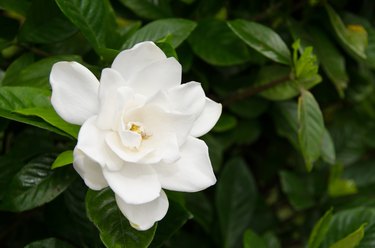
Gardenias are famously particular, and it is a challenge to keep them in their best condition, particularly in the event of a hard freeze. Unfortunately, if your gardenia has freeze damage, you will need to do some troubleshooting. You still may not want to get your hopes up on any flowers in that growing season.
Evaluating Gardenia Freeze Damage
Video of the Day
While leaves can turn brown or even black after undergoing a hard freeze, this only indicates that those leaves are damaged. It doesn't indicate whether or not the branches or entire plant has died.
Video of the Day
Agricultural experts advise a "scratch test," to see if live, green wood is present under a darker, damaged surface. Instead of taking drastic action immediately, wait for the first new buds and branches to start appearing, then see if there are any sections that are still viable.
Helping Your Gardenia Bush Recover
Unless something truly dramatic has happened, a healthy root ball underground should have survived even a hard freeze. In a worst-case scenario, you can prune the bush down to the ground and start over, but that is the last resort before digging up the plant and just starting over.
Once your gardenia has shown signs of life and you've assessed which broken or dead branches need to be pruned, spring into action. The best process for pruning your gardenia bushes starts with the scratch test. Although the best time to prune is in late summer or early fall, use the scratch test to determine dead branches and prune them before new buds appear in May.
Keep your shears at a 45-degree angle relative to the branch, and cut at the base. Use sharp shears and wipe the blades with a disinfected rag before and after each cut to avoid transmitting disease. Do not water the plant for a few hours after pruning.
Try pinching off any buds appearing in the month of May to encourage them to resprout in June, resulting in a more densely leafed bush. The goal of this approach is to create plenty of concentrated new growth to replace the branches and leaves lost to pruning and the freeze. Be sure to keep the soil moist, not soaking, and otherwise wait for the plant to recover on its own.
Preventing Gardenia Freeze Damage
Gardenia freeze tolerance is quite low, given that it grows in USDA plant hardiness zones 8 to 10 (on the warmer end of the spectrum). If possible, keep your gardenia in a pot, to allow you to bring it indoors during colder nights or seasons.
If you have permanently planted your gardenia bush outdoors, but are expecting unseasonably cold weather for any length of time, you should protect your plants. In cold weather, you can cover your gardenias with a blanket or a kind of netting with built-in structure to help prevent the weight of snow from causing breakage. This is available through many gardening supply companies.
As a DIY approach, consider using natural substances such as newspaper, linen and burlap instead of plastic sheeting to cover your plants in a freeze. This allows moisture to escape and the plant to "breathe" while retaining heat from the day.
- Gardening Know How: Gardenia Cold Damage: How To Treat Cold Injury Of Gardenias
- Houston Chronicle: Your Garden Froze, Now What?
- Garden Nerdy: How to Prune a Gardenia Bush in 5 Simple Steps
- Walter Reeves: Gardenia: Damaged by Freeze
- Gardenia: Learn How to Grow and Care for Your Gardenia
- The Good Earth Garden Center: Plant Recovery After a Hard Freeze
- Grow Joy: How to Cover Plants for Frost Protection